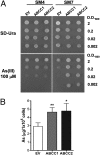Arsenic tolerance in Arabidopsis is mediated by two ABCC-type phytochelatin transporters
- PMID: 21078981
- PMCID: PMC3000282
- DOI: 10.1073/pnas.1013964107
Arsenic tolerance in Arabidopsis is mediated by two ABCC-type phytochelatin transporters
Abstract
Arsenic is an extremely toxic metalloid causing serious health problems. In Southeast Asia, aquifers providing drinking and agricultural water for tens of millions of people are contaminated with arsenic. To reduce nutritional arsenic intake through the consumption of contaminated plants, identification of the mechanisms for arsenic accumulation and detoxification in plants is a prerequisite. Phytochelatins (PCs) are glutathione-derived peptides that chelate heavy metals and metalloids such as arsenic, thereby functioning as the first step in their detoxification. Plant vacuoles act as final detoxification stores for heavy metals and arsenic. The essential PC-metal(loid) transporters that sequester toxic metal(loid)s in plant vacuoles have long been sought but remain unidentified in plants. Here we show that in the absence of two ABCC-type transporters, AtABCC1 and AtABCC2, Arabidopsis thaliana is extremely sensitive to arsenic and arsenic-based herbicides. Heterologous expression of these ABCC transporters in phytochelatin-producing Saccharomyces cerevisiae enhanced arsenic tolerance and accumulation. Furthermore, membrane vesicles isolated from these yeasts exhibited a pronounced arsenite [As(III)]-PC(2) transport activity. Vacuoles isolated from atabcc1 atabcc2 double knockout plants exhibited a very low residual As(III)-PC(2) transport activity, and interestingly, less PC was produced in mutant plants when exposed to arsenic. Overexpression of AtPCS1 and AtABCC1 resulted in plants exhibiting increased arsenic tolerance. Our findings demonstrate that AtABCC1 and AtABCC2 are the long-sought and major vacuolar PC transporters. Modulation of vacuolar PC transporters in other plants may allow engineering of plants suited either for phytoremediation or reduced accumulation of arsenic in edible organs.
Conflict of interest statement
Conflict of interest statement: Y.L., E.M., J.I.S., W.-Y.S., J.P., and D.G.M.-C. have filed a patent on the reduction of arsenic in crops and the use of ABCCs for phytoremediation based on the discovery reported in the manuscript.
Figures





Comment in
-
Arsenic tolerance in plants: "Pas de deux" between phytochelatin synthesis and ABCC vacuolar transporters.Proc Natl Acad Sci U S A. 2010 Dec 7;107(49):20853-4. doi: 10.1073/pnas.1016286107. Epub 2010 Nov 24. Proc Natl Acad Sci U S A. 2010. PMID: 21106757 Free PMC article. No abstract available.
Similar articles
-
The phytochelatin transporters AtABCC1 and AtABCC2 mediate tolerance to cadmium and mercury.Plant J. 2012 Jan;69(2):278-88. doi: 10.1111/j.1365-313X.2011.04789.x. Epub 2011 Oct 25. Plant J. 2012. PMID: 21919981
-
Phytochelatin-metal(loid) transport into vacuoles shows different substrate preferences in barley and Arabidopsis.Plant Cell Environ. 2014 May;37(5):1192-201. doi: 10.1111/pce.12227. Epub 2013 Dec 8. Plant Cell Environ. 2014. PMID: 24313707 Free PMC article.
-
Cadmium-inducible expression of the ABC-type transporter AtABCC3 increases phytochelatin-mediated cadmium tolerance in Arabidopsis.J Exp Bot. 2015 Jul;66(13):3815-29. doi: 10.1093/jxb/erv185. Epub 2015 Apr 21. J Exp Bot. 2015. PMID: 25900618 Free PMC article.
-
Long-distance transport, vacuolar sequestration, tolerance, and transcriptional responses induced by cadmium and arsenic.Curr Opin Plant Biol. 2011 Oct;14(5):554-62. doi: 10.1016/j.pbi.2011.07.004. Epub 2011 Aug 5. Curr Opin Plant Biol. 2011. PMID: 21820943 Free PMC article. Review.
-
Arsenic and antimony transporters in eukaryotes.Int J Mol Sci. 2012;13(3):3527-3548. doi: 10.3390/ijms13033527. Epub 2012 Mar 15. Int J Mol Sci. 2012. PMID: 22489166 Free PMC article. Review.
Cited by
-
Comparison of early transcriptome responses to copper and cadmium in rice roots.Plant Mol Biol. 2013 Mar;81(4-5):507-22. doi: 10.1007/s11103-013-0020-9. Epub 2013 Feb 12. Plant Mol Biol. 2013. PMID: 23400832
-
The SLIM1 transcription factor is required for arsenic resistance in Arabidopsis thaliana.FEBS Lett. 2021 Jun;595(12):1696-1707. doi: 10.1002/1873-3468.14096. Epub 2021 May 19. FEBS Lett. 2021. PMID: 33960401 Free PMC article.
-
Effects of Foliar Spraying of Dicarboxylicdimethylammonium Chloride on Cadmium and Arsenic Accumulation in Rice Grains.Toxics. 2024 Jun 7;12(6):418. doi: 10.3390/toxics12060418. Toxics. 2024. PMID: 38922098 Free PMC article.
-
Analysis of sublethal arsenic toxicity to Ceratophyllum demersum: subcellular distribution of arsenic and inhibition of chlorophyll biosynthesis.J Exp Bot. 2016 Aug;67(15):4639-46. doi: 10.1093/jxb/erw238. Epub 2016 Jun 23. J Exp Bot. 2016. PMID: 27340233 Free PMC article.
-
Functional Characterization of a Gene in Sedum alfredii Hance Resembling Rubber Elongation Factor Endowed with Functions Associated with Cadmium Tolerance.Front Plant Sci. 2016 Jun 29;7:965. doi: 10.3389/fpls.2016.00965. eCollection 2016. Front Plant Sci. 2016. PMID: 27446189 Free PMC article.
References
-
- Williams PN, et al. Variation in arsenic speciation and concentration in paddy rice related to dietary exposure. Environ Sci Technol. 2005;39:5531–5540. - PubMed
-
- Meharg AA, Rahman MM. Arsenic contamination of Bangladesh paddy field soils: Implications for rice contribution to arsenic consumption. Environ Sci Technol. 2003;37:229–234. - PubMed
-
- World Health Organization . Arsenic in Drinking Water. Geneva: WHO; 2001.
-
- Smedley PL, Kinniburgh DG. A review of the source, behaviour and distribution of arsenic in natural waters. Appl Geochem. 2002;17:517–568.
-
- Nordstrom DK. Public health. Worldwide occurrences of arsenic in ground water. Science. 2002;296:2143–2145. - PubMed
Publication types
MeSH terms
Substances
Grants and funding
LinkOut - more resources
Full Text Sources
Other Literature Sources
Medical
Molecular Biology Databases
Research Materials

